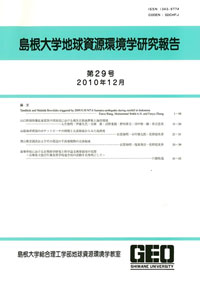島根大学総合理工学部地球資源環境学教室
ISSN:1343-9774

number of downloads : ?
Use this link to cite this item : https://ir.lib.shimane-u.ac.jp/35669
Geoscience reports of Shimane University 34
2016-03-05 発行
島根半島三津地域に分布する熱水変質ドレライトに産するぶどう石の産状と化学組成の関係
Relation between occurrence and chemical compositions of prehnite in hydrothermally altered dolerite from Mitsu, Shimane Peninsula, Japan.
Nagashima, Mariko
Iwasa, Kiyoka
Akasaka, Masahide
File
Description
Some secondary minerals such as prehnite, pumpellyite, babingtonite and laumontite occur in druses, veins, and nodular aggregates in the hydrothermally altered Miocene dolerite sills distributing in the north coast of Shimane Peninsula, Japan. This study gives a special focus on the occurrence of prehnite from Mitsu area. Prehnite shows two modes of occurrences: a druse and vein mineral (prehnite I) which is associated with Fe-rich pumpellyite and laumontite, and a replacement of the primary plagioclase (prehnite II). Main minerals in rock specimens containing prehnite I are plagioclase and K-feldspar, but they are not observed in those containing prehnite II. Total Fe_2O_3 contents of prehnite I and II attain up to 8.14 and 8.61 wt.%, respectively. The Fe content of prehnite I varies in a range between 0.33 and 0.44 Fe^<3+> atoms per formula unit (apfu; per O_<10>(OH)_2), whereas the Fe content of prehnite II from 0.01 to 0.46 Fe^<3+> apfu. Their different compositional ranges can be due to the formation process: prehnite I formed directly from hydrothermal fluids and / or vapor in the druses and fissures; prehnite II occurring as pseudomorph of plagioclase was crystallized through alteration process of plagioclase by hydrothermal fluids / vapor. In general, iron in prehnite is ferric in prehnite. However, in some prehnite I grains deficient in Ca, Fe^<2+> is assumed to replace a part of Ca.
Other Article
PP. xxi - xxiv
PP. 9 - 14
PP. 69 - 75
PP. 89 - 93
